Alberta
Alberta reaching out to Canadians to help kill Ottawa’s job-killing cap on energy production
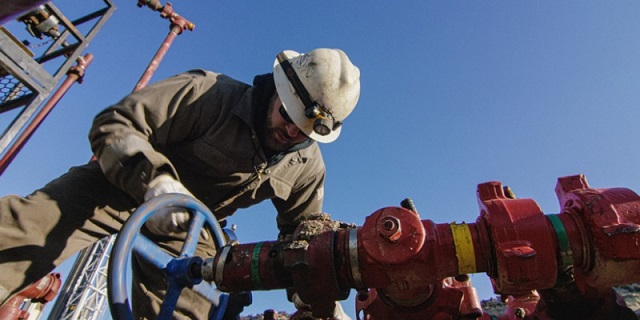
Scrap the Cap |
S&P Global Commodity Insights found that a 40 per cent emissions cap could lead to a reduction in oil and natural gas production of one million barrels per day by 2030 and a 2.1-million barrel reduction by 2035.
Independent analysis by the Conference Board of Canada, Deloitte and S&P Global tell the same story: the federal government’s proposed cap would require oil and gas production cuts that would put people out of work and drain billions from Canada’s economy. Despite these reports and continued opposition from many provinces, industry, businesses, experts and Canadians, the federal government will soon release its draft regulations.
The proposed emissions cap is a production cap. S&P Global Commodity Insights found that a 40 per cent emissions cap could lead to a reduction in oil and natural gas production of one million barrels per day by 2030 and a 2.1-million barrel reduction by 2035. According to the Conference Board of Canada and Deloitte, the cap could amount to a more than 10 per cent reduction in oil production and a 16 per cent reduction in conventional gas production in Alberta in 2030.
Alberta’s government is launching a national advertising campaign to inform Canadians that this cap will lead our province and country into economic and societal decline. Alberta would be hit hardest and in 2040, the province’s GDP would shrink by 4.5 per cent. Canada’s would decline by 1 per cent. The cap would result in 150,000 Canadians losing their jobs and the loss of $14 billion a year from the economy. The average Canadian family would be left with up to $419 less per month to spend on groceries, housing or fuel, impacting the quality of life Canadians enjoy coast to coast to coast.
All Canadians deserve to know the dangers of this cap, which will negatively impact their families without reducing global emissions whatsoever.
“Once again, Ottawa is attempting to set policies that are shortsighted and reckless. We’re challenging proposed policy that would stifle our energy industry, kill jobs and ruin economies by launching a national campaign that tells Ottawa to “Scrap the Cap.” We’re telling the federal government to forget this reckless and extreme idea and get behind Alberta’s leadership by investing in real solutions that cut emissions, not Canada’s prosperity.”
The proposed cap will put safe, reliable and secure energy at risk while costing tens of thousands of jobs and billions in lost federal revenue that pays for important programs, services and infrastructure. This means lost jobs, hurt families shuttered businesses and less revenue going to the schools, hospitals, programs and services every Canadian relies on.
If left unchanged, this cap would force Canada’s energy industry to curtail production at the expense of struggling Canadian families. When production is cut, jobs, tax revenues and the economy are cut too. It is, in effect, a cap on prosperity that would be felt across the country.
Alberta is encouraging Canadians to visit the Scrap the Cap website and tell Ottawa they cannot and will not support a cap on energy production that leaves Canadians with a lower standard of living and reduced services. Print, television and social media advertisements will run nationwide from Oct. 15 to the end of November to urge Canadians to contact their member of parliament (MP) and share their thoughts. The Scrap the Cap website includes a letter that can be sent electronically.
“We will not stand by while the federal government threatens tens of thousands of jobs. This production cap means billions in revenues down the drain, and we will not let our province’s – or our country’s – economic future be gutted by an out-of-touch federal government. There is a way to reduce emissions without killing the economy… but this unconstitutional production cap is not it.”
“A cap on oil and gas production will kill jobs and investment and adds to the growing list of federal programs that will kill investments in decarbonization. All Canadians need to let Ottawa know how this cap hurts Alberta and risks Canada’s energy security.”
Alberta is reducing emissions through common sense, incentives and technologies, not taxes or punitive regulations. The oil sands emissions intensity per barrel has fallen 23 per cent since 2009 and is expected to decline another 28 per cent by 2035. Alberta’s overall emissions, electricity emissions and methane emissions are all declining, even as energy demand rises and the economy grows.
The province aspires to be carbon neutral by 2050 without cutting jobs or compromising affordable, reliable and secure energy for Albertans, Canadians and the world.
Related information
- Scrap the Cap website
- Proposed federal oil and gas emissions cap regulatory framework: Government of Alberta technical submission
- Deloitte: Potential Economic Impact of the Proposed Federal Oil and Gas Emissions Cap
- S&P Global Commodity Insights: Economic Impact Assessment of Canadian Conventional Oil and Gas
- Conference Board of Canada: Economic Impacts of a Greenhouse Gas Emissions Cap on the Oil and Gas Sector
- Alberta’s emissions reduction and energy development plan
Related news
- It’s time to scrap the cap: Joint statement (May 27, 2024)
Alberta
Median workers in Alberta could receive 72% more under Alberta Pension Plan compared to Canada Pension Plan
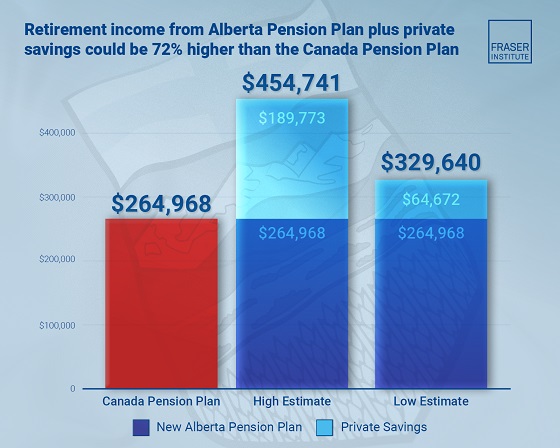
From the Fraser Institute
By Tegan Hill and Joel Emes
Moving from the CPP to a provincial pension plan would generate savings for Albertans in the form of lower contribution rates (which could be used to increase private retirement savings while receiving the same pension benefits as the CPP under the new provincial pension), finds a new study published today by the Fraser Institute, an independent, non-partisan Canadian public policy think-tank.
“Due to Alberta’s comparatively high rates of employment, higher average incomes, and younger population, Albertans would pay a lower contribution rate through a separate provincial pension plan while receiving the same benefits as under the CPP,” said Tegan Hill, director of Alberta policy at the Fraser Institute and co-author of Illustrating the Potential of an Alberta Pension Plan.
Assuming Albertans invested the savings from moving to a provincial pension plan into a private retirement account, and assuming a contribution rate of 5.85 per cent, workers earning the median income in Alberta ($53,061 in 2025) could accrue a stream of retirement payments totalling $454,741 (pre-tax)—a 71.6 per cent increase from their stream of CPP payments ($264,968).
Put differently, under the CPP, a median worker receives a total of $264,968 in retirement income over their life. If an Alberta worker saved the difference between what they pay now into the CPP and what they would pay into a new provincial plan, the income they would receive in retirement increases. If the contribution rate for the new provincial plan was 5.85 per cent—the lower of the available estimates—the increase in retirement income would total $189,773 (or an increase of 71.6 per cent).
If the contribution rate for a new Alberta pension plan was 8.21 per cent—the higher of the available estimates—a median Alberta worker would still receive an additional $64,672 in retirement income over their life, a marked increase of 24.4 per cent compared to the CPP alone.
Put differently, assuming a contribution rate of 8.21 per cent, Albertan workers earning the median income could accrue a stream of retirement payments totaling $329,640 (pre-tax) under a provincial pension plan—a 24.4 per cent increase from their stream of CPP payments.
“While the full costs and benefits of a provincial pension plan must be considered, its clear that Albertans could benefit from higher retirement payments under a provincial pension plan, compared to the CPP,” Hill said.
Illustrating the Potential of an Alberta Pension Plan
- Due to Alberta’s comparatively high rates of employment, higher average incomes, and younger population, Albertans would pay a lower contribution rate with a separate provincial pension plan, compared with the CPP, while receiving the same benefits as under the CPP.
- Put differently, moving from the CPP to a provincial pension plan would generate savings for Albertans, which could be used to increase private retirement income. This essay assesses the potential savings for Albertans of moving to a provincial pension plan. It also estimates an Albertan’s potential increase in total retirement income, if those savings were invested in a private account.
- Depending on the contribution rate used for an Alberta pension plan (APP), ranging from 5.85 to 8.2 percent, an individual earning the CPP’s yearly maximum pensionable earnings ($71,300 in 2025), would accrue a stream of retirement payments under the total APP (APP plus private retirement savings), yielding a total retirement income of between $429,524 and $584,235. This would be 22.9 to 67.1 percent higher, respectively, than their stream of CPP payments ($349,545).
- An individual earning the median income in Alberta ($53,061 in 2025), would accrue a stream of retirement payments under the total APP (APP plus private retirement savings), yielding a total retirement income of between $329,640 and $454,741, which is between 24.4 percent to 71.6 percent higher, respectively, than their stream of CPP payments ($264,968).

Joel Emes
Alberta
Alberta ban on men in women’s sports doesn’t apply to athletes from other provinces

From LifeSiteNews
Alberta’s Fairness and Safety in Sport Act bans transgender males from women’s sports within the province but cannot regulate out-of-province transgender athletes.
Alberta’s ban on gender-confused males competing in women’s sports will not apply to out-of-province athletes.
In an interview posted July 12 by the Canadian Press, Alberta Tourism and Sport Minister Andrew Boitchenko revealed that Alberta does not have the jurisdiction to regulate out-of-province, gender-confused males from competing against female athletes.
“We don’t have authority to regulate athletes from different jurisdictions,” he said in an interview.
Ministry spokeswoman Vanessa Gomez further explained that while Alberta passed legislation to protect women within their province, outside sporting organizations are bound by federal or international guidelines.
As a result, Albertan female athletes will be spared from competing against men during provincial competition but must face male competitors during inter-provincial events.
In December, Alberta passed the Fairness and Safety in Sport Act to prevent biological men who claim to be women from competing in women’s sports. The legislation will take effect on September 1 and will apply to all school boards, universities, as well as provincial sports organizations.
The move comes after studies have repeatedly revealed what almost everyone already knew was true, namely, that males have a considerable advantage over women in athletics.
Indeed, a recent study published in Sports Medicine found that a year of “transgender” hormone drugs results in “very modest changes” in the inherent strength advantages of men.
Additionally, male athletes competing in women’s sports are known to be violent, especially toward female athletes who oppose their dominance in women’s sports.
Last August, Albertan male powerlifter “Anne” Andres was suspended for six months after a slew of death threats and harassments against his female competitors.
In February, Andres ranted about why men should be able to compete in women’s competitions, calling for “the Ontario lifter” who opposes this, apparently referring to powerlifter April Hutchinson, to “die painfully.”
Interestingly, while Andres was suspended for six months for issuing death threats, Hutchinson was suspended for two years after publicly condemning him for stealing victories from women and then mocking his female competitors on social media. Her suspension was later reduced to a year.
-
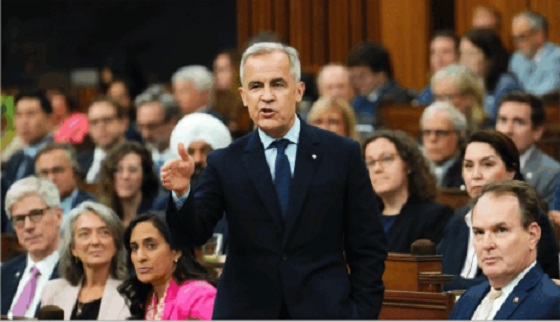
 Business1 day ago
Business1 day agoMark Carney’s Fiscal Fantasy Will Bankrupt Canada
-

 Entertainment2 days ago
Entertainment2 days agoStudy finds 99% of late-night TV guests in 2025 have been liberal
-
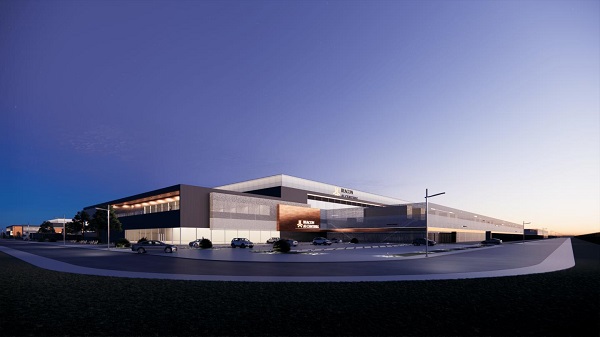
 Alberta24 hours ago
Alberta24 hours agoTemporary Alberta grid limit unlikely to dampen data centre investment, analyst says
-
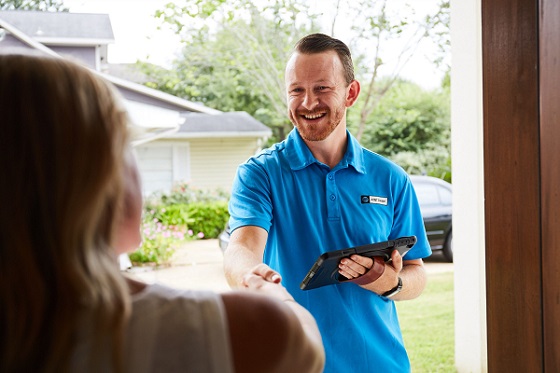
 Opinion1 day ago
Opinion1 day agoCharity Campaigns vs. Charity Donations
-

 Frontier Centre for Public Policy2 days ago
Frontier Centre for Public Policy2 days agoCanada’s New Border Bill Spies On You, Not The Bad Guys
-

 Daily Caller19 hours ago
Daily Caller19 hours ago‘Strange Confluence Of Variables’: Mike Benz Wants Transparency Task Force To Investigate What Happened in Butler, PA
-

 Uncategorized2 days ago
Uncategorized2 days agoCNN’s Shock Climate Polling Data Reinforces Trump’s Energy Agenda
-

 Opinion1 day ago
Opinion1 day agoPreston Manning: Three Wise Men from the East, Again




